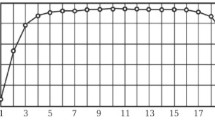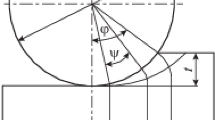Abstract
The prospects for improving the quality of articles from ceramics are considered from the standpoint of synergetics, i.e., the science studying the self-organization of systems. The main problem to be solved by production engineers consists in determining the bifurcation points, establishing methods for controlling the behavior of the system in them and, sometimes, eliminating the bifurcations. Sintering of binary oxides and their mixtures is considered as an example for showing that the methods of mathematical design of experiments make it possible to determine and eliminate bifurcation points and reduce the level of noises in them, which improves the quality of the articles.
Similar content being viewed by others
References
H.-O. Pitegen and P. H. Richter,The Beauty of Fractals. Images of Complex Dynamic Systems [Russian translation], Mir, Moscow (1993).
V. S. Bakunov and A. V. Belyakov, “Prospects of improving the reproducibility of the structure and properties of ceramics,”Ogneup. Tekh. Keram., No. 2 (1997).
P. Glansdorff and I. Prigogine,Thermodynamic Theory of Structure, Stability and Fluctuations, Wiley, London (1971).
G. Nikolis and I. Prigozhin,Self-Organization in Nonequilibrium Systems. From Dissipative Structures to Order through Fluctuations [Russian translation], Mir, Moscow (1979).
H. Haken,Synergetics, Springer, Heidelberg (1978).
V. S. Bakunov and A. V. Belyakov, “On the problem of analyzing the structure of ceramics,”Neorg. Mater.,32(2), 243–248 (1996).
V. S. Bakunov and A. V. Belyakov, “Thermal stability and the structure of ceramics,”Neorg. Mater.,33(12), 1533–1536 (1997).
B. B. Mandelbrot,The Fractal Geometry of Nature, W. H. Freeman and Company, San Francisco (1982).
V. S. Ivanova, A. S. Balankin, I. Zh. Bunin, et al.,Synergetics and Fractals in Materials Science [in Russian], Nauka, Moscow (1994).
E. Feder,Fractals [Russian translation], Mir, Moscow (1991).
T. A. Witten and L. M. Sander, “Diffusion-limited aggregation,”Phys. Rev.,27, 5686–5697 (1983).
P. J. Meakin, “Diffusion-limited aggregation in three dimensions: results from a new cluster-cluster aggregation model,”Colloid. Interface Sci.,102(2), 491–504 (1984).
E.A. Gudilin, N. N. Oleinikov, A. N. Baranov, and Yu. D. Tret’yakov, “Simulating evolution processes in polycrystalline systems that appear in crystallization of melts,”Neorg. Mater.,29(11), 1443–1448 (1993).
Yu. D. Tret’yakov N. N. Oleinikov, E. A. Gudilin, et al., “Self-organization of physicochemical systems in creating new materials,”Neorg. Mater.,30(3), 291–305 (1994).
V. V. Kafarov,Methods of Cybernetics in Chemistry and Chemical Technology [in Russian], Khimiya, Moscow-Leningrad (1971).
S. L. Akhnazarova and V. V. Kafarov,Optimization of Experiments in Chemistry and Chemical Technology [in Russian], Vysshaya Shkola, Moscow (1978).
V. S. Bakunov, V. L. Balkevich, A. S. Vlasov, et al.,Ceramics from Highly Refractory Oxides [in Russian], Metallurgiya, Moscow (1977).
S. S. Apoyan, T. V. Efimovskaya, V. S. Bakunov, and R. Ya. Popil’skii, “Some special features of solid phase synthesis and sintering of chrome-magnesium spinel in joint annealing,”Steklo Keram., No. 8, 32–34 (1977).
Kh. V. Kuliev, R. Ya. Popil’skii, and V. S. Bakunov, “Formation of the phase composition and sintering of magnesiochromite granular ceramics,”Steklo Keram., No. 6, 22–24 (1983).
A. V. Belyakov, R. Ya. Popil’skii, A. S. Vlasov, et al., “Synthesis of materials in the ZrO2−SrO system,”Izv. Akad. Nauk SSSR, Ser. Neorg. Mater.,24(1), 80–83 (1988).
V. K. Vorob’ev, D. N. Poluboyarinov, and V. S. Bakunov, “Changes in conductivity in sintering of corundum ceramics,”Izv. Akad. Nauk SSSR, Ser. Neorg. Mater.,7(5), 260–266 (1971).
Author information
Authors and Affiliations
Additional information
Translated from Steklo i Keramika, No. 2, pp. 14–18, February, 1998.
Rights and permissions
About this article
Cite this article
Belyakov, A.V., Bakunov, V.S. Stability of the quality of articles in the ceramics industry. Glass Ceram 55, 44–48 (1998). https://doi.org/10.1007/BF03180146
Issue Date:
DOI: https://doi.org/10.1007/BF03180146




